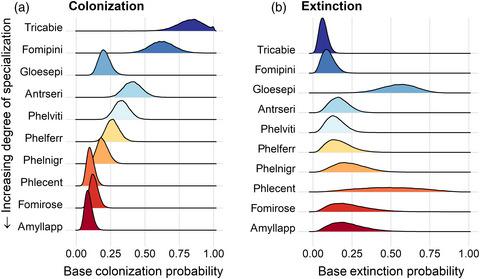Our official English website, www.x-mol.net, welcomes your
feedback! (Note: you will need to create a separate account there.)
Long‐term effects of colonization–extinction dynamics of generalist versus specialist wood‐decaying fungi
Journal of Ecology ( IF 5.3 ) Pub Date : 2020-10-15 , DOI: 10.1111/1365-2745.13526 Helen Moor 1 , Jenni Nordén 2 , Reijo Penttilä 3 , Juha Siitonen 3 , Tord Snäll 1
中文翻译:

普通木材腐烂和专业木材腐烂真菌的定殖-灭绝动力学的长期影响
更新日期:2020-10-15
Journal of Ecology ( IF 5.3 ) Pub Date : 2020-10-15 , DOI: 10.1111/1365-2745.13526 Helen Moor 1 , Jenni Nordén 2 , Reijo Penttilä 3 , Juha Siitonen 3 , Tord Snäll 1
Affiliation

|
- Long‐term metapopulation persistence is mediated by the dynamics of colonization and extinction. To understand and predict future species occupancy in changing landscapes, we must account for the dynamic rates that shape the occupancy and disentangle their dependence on environmental conditions. Specialist and generalist species may differ in their dynamics in systematic ways.
- Using an extensive, large‐scale repeat survey dataset for wood‐decaying fungi, we fitted dynamic metapopulation models for ten species, ranging from generalists to specialists with differing resource requirements. We first estimated base rates of colonization and extinction and tested their relationships to species' degree of specialization. We then tested for effects of local and landscape scale variables on the colonization and extinction rates. Finally, using the fitted models and a scenario of future forest development we projected future colonization–extinction dynamics over 100 years to test for differences in species occupancies between production stands and set‐aside stands.
- Our study revealed a striking pattern of decreasing colonization rates with increasing degree of specialization across species, along with concomitantly increasing extinction rates. Strong sensitivity of colonization probabilities to local habitat quality (dead wood volume and stand age) in specialist but not generalist species constrained the regional occupancy of specialists, especially in production forest. We found evidence for short‐range dispersal limitation in two specialists, but no effect of our measure for landscape‐scale connectivity on colonization rates. Simulations of future metapopulation dynamics resulted in decreasing and lower final occupancy in production forest than in set‐asides, especially of specialist species. In set‐aside stands, however, specialists increased over time to relatively high occupancies.
- Synthesis. Colonization–extinction dynamics of wood‐decaying fungi varied with species' degree of specialization. Increasing specialization was associated with increasing sensitivity of colonization rates to habitat conditions, and partly local connectivity, as well as with increasing extinction rates. Low landscape‐scale occupancies of specialist as compared to generalist wood‐decaying fungi are thus maintained by a combination of lower colonization rates, particularly in production forest, and higher extinction rates.
中文翻译:

普通木材腐烂和专业木材腐烂真菌的定殖-灭绝动力学的长期影响
- 长期的种群持久性是由定殖和灭绝的动力学介导的。为了了解和预测未来物种在不断变化的景观中的占有率,我们必须考虑塑造占有率的动态速率,并弄清它们对环境条件的依赖性。专家和通才物种的动力学可能会系统地有所不同。
- 我们使用了广泛的,大规模的木材腐烂真菌的重复调查数据集,我们为十个物种(从通才到具有不同资源需求的专家)拟合了动态种群模型。我们首先估算定殖和灭绝的基本速率,并测试它们与物种专业化程度的关系。然后,我们测试了局部和景观尺度变量对定居和灭绝率的影响。最后,使用拟合模型和未来森林发展的情景,我们预测了未来100年的定殖灭绝动态,以检验生产林和备用林之间物种占用的差异。
- 我们的研究揭示了一个显着的模式,即随着物种间专业化程度的提高,殖民化率下降,同时灭绝率也随之上升。专门物种而不是通才物种对定居概率对当地生境质量(枯木体积和林分年龄)的强烈敏感性限制了特别是在生产林中的专家的区域占有率。我们在两名专家中发现了短程分散限制的证据,但我们对景观尺度连通性的测量对殖民化率没有影响。通过模拟未来的种群动态,生产林中的最终占有率将降低,并且比定居者(特别是特种物种)的最终占有率更低。但是,在预留的看台上,随着时间的流逝,专家人数增加了。
- 综合。木材腐烂真菌的定殖灭绝动力学随物种的专业化程度而变化。专业化程度的提高与殖民化率对生境条件敏感性的提高,部分地区的连通性以及灭绝率的提高有关。因此,与较低的木材腐烂真菌相比,较低的专家在景观尺度上的占用率是由于较低的定殖率(尤其是在生产林中)和较高的灭绝率共同导致的。











































 京公网安备 11010802027423号
京公网安备 11010802027423号